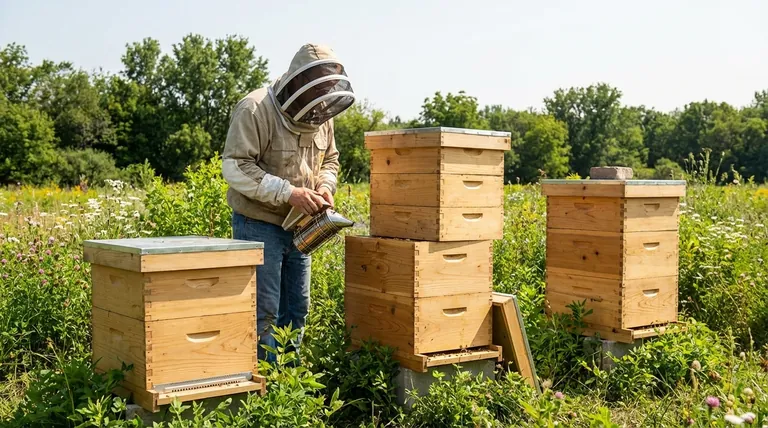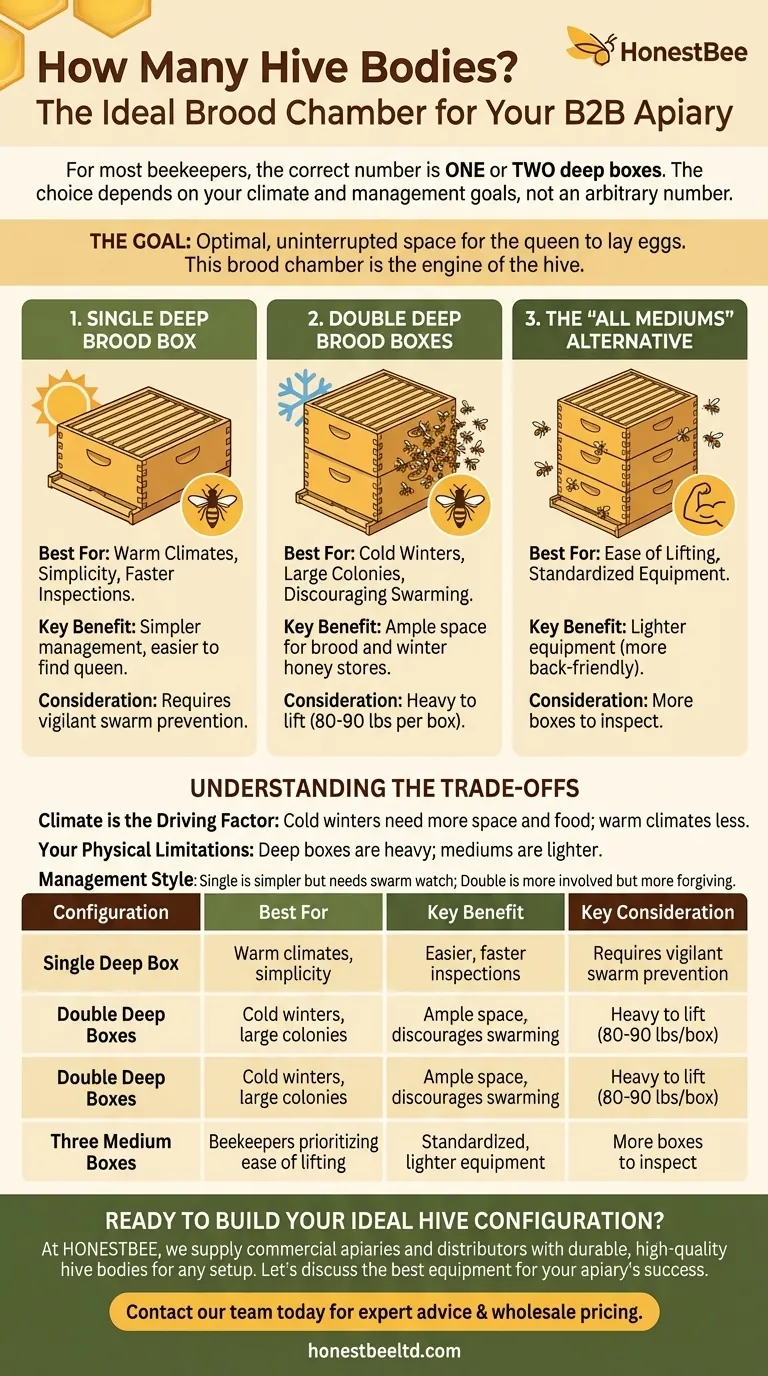For most beekeepers, the correct number is one or two hive bodies. A standard Langstroth beehive configuration uses either a single deep box or two deep boxes stacked on top of each other to serve as the brood chamber. The choice between one and two is a critical decision determined primarily by your local climate and management goals, not an arbitrary number.
The goal is not to use a specific number of boxes, but to provide the queen with the optimal, uninterrupted space she needs to lay eggs. This "brood chamber" is the engine of the hive, and its size directly impacts colony health, population growth, and survival.

The Purpose of a Hive Body (The Brood Chamber)
To decide on a number, you must first understand the specific function of a hive body. This isn't just another box; it's the heart of the colony.
What is a Hive Body?
A hive body, often called a brood box or deep, is where the colony raises its young. It is the nest and nursery of the hive.
Inside, you will find the queen laying eggs, frames of developing larvae and pupae (brood), and the immediate food stores of pollen and honey required to feed them.
Hive Bodies vs. Honey Supers
A common point of confusion is the difference between a hive body and a honey super.
A hive body is the bees' living quarters. A honey super is a smaller box placed on top of the hive body specifically for the bees to store surplus honey—the honey you intend to harvest. We keep the queen out of the honey supers using a queen excluder.
Choosing Your Brood Chamber Configuration
Your core decision is whether to run a single-box or double-box brood chamber. Each has distinct advantages and is suited to different conditions.
The Single-Deep Brood Box
This setup uses one deep hive body as the sole brood chamber. All honey supers are placed directly on top of this single box.
This is a common method in regions with long summers and very mild winters, where bees don't need to store massive amounts of honey to survive. It makes finding the queen and performing inspections faster.
The Double-Deep Brood Box
This is arguably the most common configuration, especially in climates with cold winters. It uses two deep hive bodies stacked together for the brood chamber.
This provides ample space for a prolific queen to lay, discouraging swarming. The top box also serves as a large pantry, allowing the bees to store significant honey reserves for winter right above their cluster.
The "All Mediums" Alternative
Some beekeepers standardize all their equipment to one size: the medium super.
In this system, you might use three medium boxes for the brood chamber instead of two deeps. The primary benefit is weight; a medium box full of honey is significantly lighter and easier to lift than a full deep box.
Understanding the Trade-offs
There is no single "best" setup. Your choice is a balance between the needs of the bees and your own practical limitations as a beekeeper.
Climate is the Driving Factor
Cold climates with long winters demand a larger brood nest and significant food stores. The double-deep configuration is the standard here because it provides the necessary space for both a large winter cluster and the honey to feed it.
Warm climates with short, mild winters allow bees to forage for much of the year. A single-deep brood box is often sufficient, as the colony doesn't need to stockpile as much food.
Your Physical Limitations
Do not underestimate the weight of a full deep hive body. It can easily weigh 80-90 lbs (36-41 kg).
If lifting this much weight is a concern, the "all mediums" approach is an excellent, back-friendly alternative. Managing three lighter boxes instead of two heavy ones can make beekeeping more sustainable and enjoyable.
Management Style and Goals
A single-deep setup can feel simpler to manage, as you only have one box to inspect for brood health. However, you must be more vigilant about swarm management, as a strong colony can run out of space quickly.
A double-deep setup is more forgiving regarding space, but inspections are more involved, as you may need to check 20 frames across two boxes to assess the colony.
Making the Right Choice for Your Hive
Instead of seeking a magic number, evaluate your specific situation to determine the ideal configuration for your hives.
- If your primary focus is surviving cold winters: Use a double-deep (two-box) brood chamber. This is the most reliable setup for ensuring your bees have enough room and food.
- If your primary focus is simplicity in a warm climate: A single-deep (one-box) brood chamber is highly effective and simplifies hive inspections.
- If your primary focus is avoiding heavy lifting: Standardize on medium-sized equipment and use three medium boxes for your brood chamber.
Ultimately, the best configuration is one that allows your colony to thrive while fitting your climate and your personal ability to manage the hive.
Summary Table:
| Configuration | Best For | Key Benefit | Key Consideration |
|---|---|---|---|
| Single Deep Box | Warm climates, simplicity | Easier, faster inspections | Requires vigilant swarm prevention |
| Double Deep Boxes | Cold winters, large colonies | Ample space, discourages swarming | Heavy to lift (80-90 lbs per box) |
| Three Medium Boxes | Beekeepers prioritizing ease of lifting | Standardized, lighter equipment | More boxes to inspect during management |
Ready to build your ideal hive configuration?
At HONESTBEE, we supply commercial apiaries and beekeeping equipment distributors with the durable, high-quality hive bodies and equipment needed for any setup. Whether you're managing a single-deep operation in a warm climate or a robust double-deep system for cold winters, our wholesale-focused operations ensure you get the reliable supplies your business depends on.
Let's discuss the best equipment for your apiary's success. Contact our team today for expert advice and wholesale pricing.
Visual Guide

Related Products
- Long Langstroth Style Horizontal Top Bar Hive for Wholesale
- Plastic Bee Hive Stand for Beekeeping
- Wholesales Dadant Size Wooden Bee Hives for Beekeeping
- Multi-Functional Sliding Hive Entrance for Beekeeping
- Professional Insulated Plastic Bee Hives
People Also Ask
- What are the most popular types of hives besides the Langstroth? Top Bar & Horizontal Hives Explained
- How does the top bar hive help control varroa mites? A Natural Approach to Mite Management
- What are the main differences between Langstroth hives and top bar hives? Choose the Right Hive for Your Beekeeping Goals
- What are the box management requirements for a top bar hive vs. Langstroth? Choose Your Hive Strategy
- What are the advantages of a top bar hive? Simpler, Bee-Centric Beekeeping for All



















